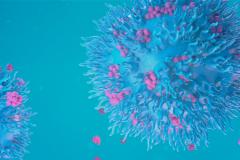When Ali’s son Howard* was still not crawling, rolling over or meeting her gaze at 10 months old, the experienced mother-of-two knew something was wrong. Despite assurances from friends and family that everything was fine, Ali brought it up with her family doctor. After rounds of tests and specialist appointments, an MRI scan revealed damaged tissue in the area of Howard’s brain that integrates motor, sensory and cognitive abilities. The doctor said the damage was so severe, it was unlikely Howard would ever be able to live on his own.
Along with the devastating prognosis, questions plagued Howard’s parents about how this had happened, whether the condition would get worse over time, and what a lifetime of support might mean.
“As a mother I couldn’t stop myself from wondering what I had done to cause this,” said Ali. “The sense of guilt was crushing.”
 A few years later, Ali heard of the research being conducted at BC Children’s Hospital and contacted Dr. William Gibson, a BC Children’s Hospital investigator and clinical geneticist, to find out whether Howard’s unexplained condition might be caused by a genetic disorder.
A few years later, Ali heard of the research being conducted at BC Children’s Hospital and contacted Dr. William Gibson, a BC Children’s Hospital investigator and clinical geneticist, to find out whether Howard’s unexplained condition might be caused by a genetic disorder.
“I often see children in the clinic with delayed developmental milestones or other unusual features that could indicate a rare genetic disease,” said Dr. Gibson. “The most important thing for the children and their families in these situations is to determine what treatment or therapy may be needed to help the child live the healthiest and most fulfilling life possible and, if feasible, find the cause of the condition.”
It turned out Howard did have a new and rare genetic disorder which was highlighted last month in research published in American Journal of Medical Genetics Part C by Dr. Gibson and his PhD student, Sharri Cyrus, along with collaborators from across the globe. The study identifies 11 patients, including Howard, with a defect in the gene SUZ12 that the researchers show is responsible for childhood overgrowth, developmental delay and intellectual disability. This work cements earlier reports of individual patients into a new, previously undescribed syndrome.
“Next-generation sequencing is making it possible to identify families with rare disorders much more quickly,” said Dr. Gibson, as senior author on the study. “This means we can identify potential new therapies and improve treatment sooner for these children.”
SUZ12 helps form part of a group of proteins called the Polycomb repressive complex 2 (PRC2). This complex plays an important role in determining which part of a cell’s DNA is switched on or off. When PRC2 malfunctions, other genes in a cell’s DNA stay switched on for too long, which can lead to the overgrowth seen in patients with these conditions. PRC2 disorders may also be involved in the development of certain childhood cancers, however the number of patients is too small at this point to make any firm conclusions in the case of SUZ12-related overgrowth.
SUZ12 is the third such gene involved in forming PRC2, whose disruption has been shown to lead to overgrowth disorders.
The first of these PRC2 conditions, known as Weaver syndrome, was named after Dr. David Weaver who described the disorder in 1974. In 2011, Dr. Gibson’s work investigating genetic disorders led to the discovery of the gene for Weaver syndrome which had eluded scientists for more than 35 years.
In 2015, he and his first PhD student Ana Cohen also discovered a second syndrome involving the PRC2 gene EED — the syndrome is now called Cohen-Gibson syndrome, named after its two co-discoverers.
All three of these overgrowth syndromes — Weaver, Cohen-Gibson and the new SUZ12-related overgrowth — have separate and distinct clinical outcomes caused by mutations in genes related to the same gene-silencing complex. This current study includes the largest number of patients (10 from nine different families) with SUZ12 mutations to date.
Sharri Cyrus, first author on the new study, originally studied genetics and medicine in her native Barbados. Her passion for genetics along with her desire to help patients led her to join Dr. Gibson’s research team to study rare genetic diseases such as overgrowth syndromes.
“Because rare diseases are — by their nature — rare, it’s necessary to join large international groups to identify enough patients to understand how these conditions form, how best to treat and monitor them and work our way towards new therapies,” said Cyrus. “These networks and collaborations are the only way health professionals in regions with smaller populations can obtain the information needed to properly care for these families.”
In Canada, rare diseases are defined as affecting less than five in 10,000 Canadians. However, there are more than 7,000 rare diseases and disorders that have been identified, 80 per cent of which are genetic in origin.
According to the Canadian Organization for Rare Diseases, rare diseases combined affect one in 12 Canadians — two-thirds of whom are children. Identifying the cause of these conditions can also shed light on how that gene may be impacted in other, more common illnesses.
“These three specific disorders describe what happens when genes of the PRC2 complex are disrupted in a way that changes the shape of the protein and interferes with its ability to function properly,” said Dr. Gibson. “However, when searching genetic databases we find that many people may have more subtle mutations in these genes. Studying these extreme cases could offer insight as to how these genes affect the human body more generally, and potentially their involvement in more common diseases like cancer.”
For Howard, now 12 years old, the diagnosis has been a source of tremendous relief to his parents.
“Knowing that there was nothing that could have been done to prevent Howard’s condition has allowed us to focus on helping him live a happy life and has given us more certainty about his future. We hope that being part of this research can help clinicians better understand these disorders and lead to new treatments for families facing the same conditions.”
*Names have been changed at the request of the family




